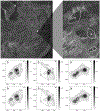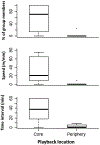The role of extragroup encounters in a Neotropical, cooperative breeding primate, the common marmoset: a field playback experiment
- PMID: 37065636
- PMCID: PMC10101152
- DOI: 10.1016/j.anbehav.2017.12.009
The role of extragroup encounters in a Neotropical, cooperative breeding primate, the common marmoset: a field playback experiment
Abstract
In cooperatively breeding species, encounters with intruders may serve multiple functions ranging from reaffirming group territory ranges to facilitating assessments for additional breeding opportunities. While these distinctive events offer the opportunity to investigate the delicate balance of these social dimensions within animal societies, their unpredictable occurrence makes witnessing and controlling these events in the wild particularly challenging. Here we used a field playback approach to simulate conspecific territorial incursions in cooperatively breeding common marmosets (Callithrix jacchus) to distinguish between the three following non-mutually exclusive functions of intergroup encounters in this species of New World primate: territorial defense, mate defense, and assessment of breeding opportunities. For these experiments, we systematically broadcast species-typical long-distance contact calls - phees - commonly used in intergroup interactions from the core and periphery of the groups' territories using either male or female vocalizations. Consistent with a territorial defense hypothesis, a group's reaction was independent of the simulated intruder's sex and the response strength was greater when the playback stimulus was broadcast from the core areas of groups' territories relative to stimulus broadcast from periphery areas. However, sex differences in some facets of their responses suggest that this is not the only potential function for these encounters. Mated males and females started to move first in response to simulated intruders of the opposite sex, suggesting that these events offered opportunities to assess extra-pair breeding opportunities, while the occurrence of females' piloerection towards simulated female intruders is suggestive of mate-guarding. These data provide unique experimental evidence for the theory that excursions by conspecific intruders may serve multiple functions in a cooperatively breeding vertebrate and are reflective of the known complexities of common marmoset sociobiology.
Keywords: Callitrichidae; common marmoset; cooperatively breeding; intergroup interactions; mate defense; mate-fidelity; neighbours assessment; sexual conflict; territory defense.
Figures




Similar articles
-
Playback responses of socially monogamous black-fronted titi monkeys to simulated solitary and paired intruders.Am J Primatol. 2015 Nov;77(11):1135-42. doi: 10.1002/ajp.22447. Epub 2015 Jul 20. Am J Primatol. 2015. PMID: 26194463
-
Partners coordinate territorial defense against simulated intruders in a duetting ovenbird.Ecol Evol. 2019 Nov 12;10(1):81-92. doi: 10.1002/ece3.5821. eCollection 2020 Jan. Ecol Evol. 2019. PMID: 31988718 Free PMC article.
-
The function of duetting in magpie-larks: conflict, cooperation, or commitment?Anim Behav. 2000 Nov;60(5):667-677. doi: 10.1006/anbe.2000.1517. Anim Behav. 2000. PMID: 11082237
-
Adaptations to subordinate status in female marmoset monkeys.Comp Biochem Physiol C Pharmacol Toxicol Endocrinol. 1998 Jun;119(3):261-74. doi: 10.1016/s0742-8413(98)00015-2. Comp Biochem Physiol C Pharmacol Toxicol Endocrinol. 1998. PMID: 9826999 Review.
-
Reproduction in captive common marmosets (Callithrix jacchus).Comp Med. 2003 Aug;53(4):364-8. Comp Med. 2003. PMID: 14524412 Review.
Cited by
-
Oxytocin modulates mate-guarding behavior in marmoset monkeys.Horm Behav. 2018 Nov;106:150-161. doi: 10.1016/j.yhbeh.2018.10.009. Epub 2018 Oct 26. Horm Behav. 2018. PMID: 30342885 Free PMC article.
-
Active Sampling in Primate Vocal Interactions.bioRxiv [Preprint]. 2023 Dec 6:2023.12.05.570161. doi: 10.1101/2023.12.05.570161. bioRxiv. 2023. Update in: Commun Biol. 2024 Sep 7;7(1):1098. doi: 10.1038/s42003-024-06764-8. PMID: 38106107 Free PMC article. Updated. Preprint.
-
Active vision during prey capture in wild marmoset monkeys.Curr Biol. 2022 Aug 8;32(15):3423-3428.e3. doi: 10.1016/j.cub.2022.06.028. Epub 2022 Jun 23. Curr Biol. 2022. PMID: 35750054 Free PMC article.
-
Spatio-temporal dynamics of ingroup interactions in macaques.Sci Rep. 2025 Aug 22;15(1):30913. doi: 10.1038/s41598-025-16391-w. Sci Rep. 2025. PMID: 40847040 Free PMC article.
-
Neural network of social interaction observation in marmosets.Elife. 2021 Mar 31;10:e65012. doi: 10.7554/eLife.65012. Elife. 2021. PMID: 33787492 Free PMC article.
References
-
- Ahnesjo I, Kvarnemo C, & Merilaita S (2001). Using potential reproductive rates to predict mating competition among individuals qualified to mate. Behavioral Ecology, 12(4), 397–401. 10.1093/beheco/12.4.397 - DOI
-
- Arruda MF, Araújo A, Sousa MBC, Albuquerque FS, Albuquerque ACSR, & Yamamoto ME (2005). Two breeding females within free-living groups may not always indicate polygyny: Alternative subordinate female strategies in common marmosets (Callithrix jacchus). Folia Primatologica, 76(1), 10–20. 10.1159/000082451 - DOI - PubMed
-
- Bales K, Dietz J, Baker A, Miller K, & Tardif SD (2000). Effects of allocare-givers on fitness of infants and parents in callitrichid primates. Folia Primatologica, 71(1–2), 27–38. - PubMed
-
- Bates D, Mächler M, Bolker B, & Walker S (2015). Fitting linear mixed-effects models using lme4. Journal of Statistical Software, 67(1), 1–48. 10.18637/jss.v067.i01 - DOI
Grants and funding
LinkOut - more resources
Full Text Sources
